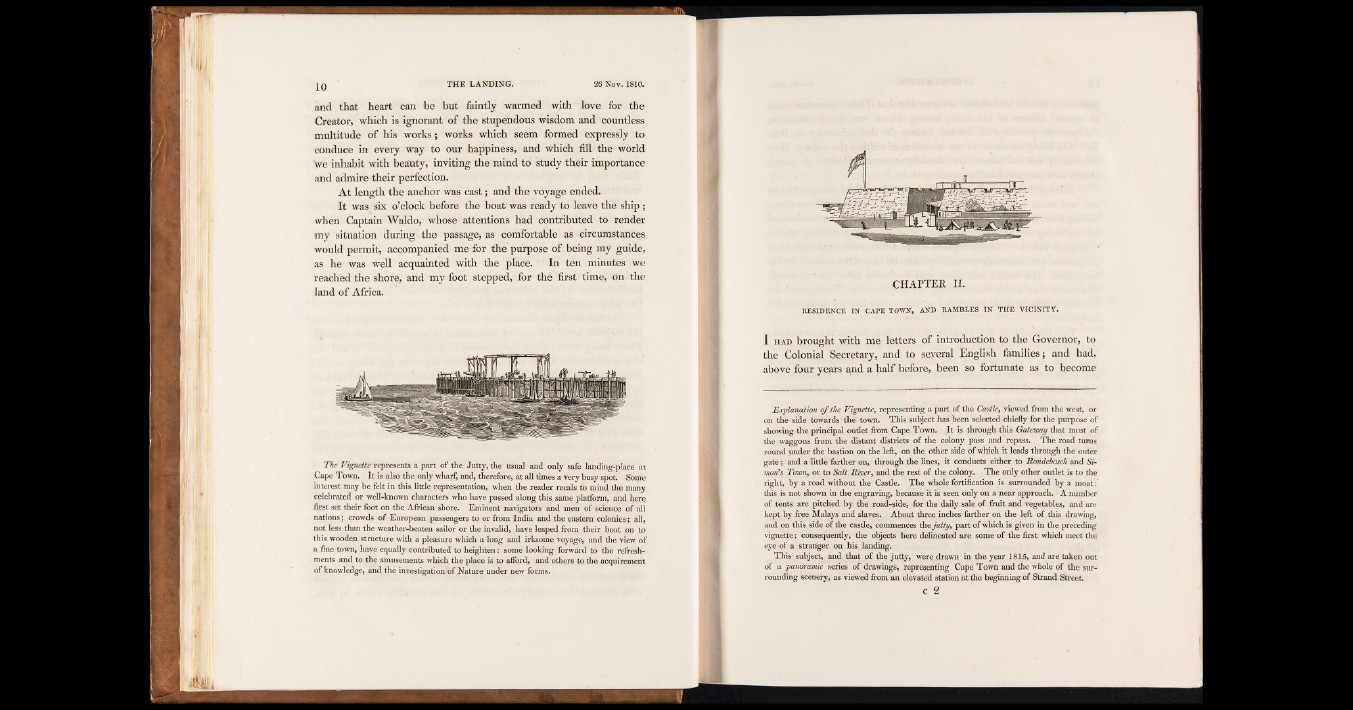
10 THE LANDING. 26 Nov. 1810.
and that heart can be but faintly warmed with love for the
Creator, which is ignorant of the stupendous wisdom and countless
multitude of his works; works which seem formed expressly to
conduce in every way to our happiness, and which fill the world
we inhabit with beaiuty, inviting the mind to study their importance
and admire their perfection.
At length the anchor was cast; and the voyage ended.
It was six o’clock before the boat was ready to leave the ship;
when Captain Waldo, whose attentions had contributed to render
my situation during the passage, as comfortable as circumstances
would permit, accompanied me for the purpose of being my guide,
as he was well acquainted with the place. In ten minutes we
reached the shore, and my foot stepped, for the first time, on the
land of Africa.
The Vignette represents a part of the Jutty, the usual and only safe landing-place at
Cape Town. I t is also the only wharf, and, therefore, at all times a very busy spot Some
interest may be felt in this little representation, when the reader recals to mind the many
celebrated or well-known characters who have passed along this same platform, and here
first set their foot on the African shore. Eminent navigators and men of science of all
nations; crowds o f European passengers to or from India and the eastern colonies; all,
not less than the weather-beaten sailor or the invalid, have leaped from their boat on to
this wooden structure with a pleasure which a long and irksome voyage, and the view of
a fine town, have equally contributed to heighten: some looking forward to the refreshments
and to the amusements which the place is to afford, and others to the acquirement
of knowledge, and the investigation of Nature under new forms.
CHAPTER II.
RESIDENCE IN CAPE TOWN, AND RAMBLES IN THE VICINITY.
I h a d brought with me letters of introduction to the Governor, to
the Colonial Secretary, and to several English families; and had,
above four years and a half before, been so fortunate as to become
Explanation o f the Vignette, representing a part of the Castle, viewed from the west, or
on the side towards the town. This subject has been selected chiefly for the purpose of
showing die principal outlet from Cape Town. I t is through this Gateway that most of
the waggons from the distant districts of the colony pass and repass. The road turns
round under the bastion on the left, on die other side of which it leads through the outer
gate; and a little farther on, through the lines, it conducts either to Rondebosch and Simon’s
Town, or to Salt River, and the rest of the colony. The only other outlet is to the
right, by a road without the Casde. The whole fortification is surrounded by a moat:
this is not shown in the engraving, because it is seen only on a near approach. A number
of tents are pitched by the road-side, for the daily sale of fruit and vegetables, and are
kept by free Malays and slaves. About three inches farther on the left of this drawing,
and on this side of the casde, commences the jutty, part of which is given in the preceding
vignette; consequendy, the objects here delineated are some of the first which meet the
eye of a stranger on his landing.
This subject, and that of the jutty, were drawn in the year 1815, and are taken out
of a panoramic series o f drawings, representing Cape Town and the whole of the surrounding
scenery, as viewed from an elevated station at the beginning of Strand Street
c 2